
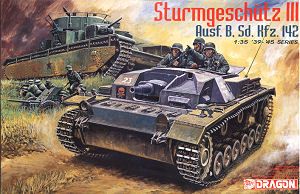
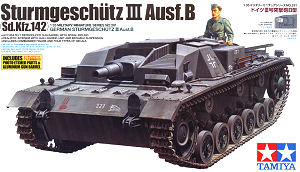
Sturmgeschütz III Ausf.B (Sd.Kfz.142)
1:35 Scale Dragon #6008 - Tamiya #35281
Kit Comparison by Terry Ashley
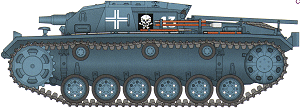




The first thing to consider is that the Dragon kit was released back in 1994 and one would think that the intervening twelve years would make a comparison pointless but only part of the Tamiya kit is new with the suspension and lower hull coming from their 1997 kit of the Panzer III Ausf.L (kit #35215) and the Dragon kit has always been considered more than respectable.
Both kits represent that same late type StuG B with front cast drive sprocket and repositioned front return roller for the 40cm track and the early stamped idler wheel and armoured smoke candle box on the rear plate.
Kit Dimensions: (an exercise in millimetres)
To start with both kits were compared to available 1:35 plans in the Achtung
Panzer book and the Jan 2006 issue of Ground Power
magazine with both plan
sets showing the same dimensions within acceptable tolerances. Also take
into account the measurements below are taking using a steel rule and Mk.1
eyeball and not some laser measuring device so all are approximate to within
fractions of millimetres.
The actual measurements as stated in the Osprey New Vanguard 19 StuG III book have the overall width at 2920mm [9’ 7”] (outside fender measurement) and overall length at 5400mm [17’ 8-½”] (outside fender measurement) which equals 83.429mm [3-¼”] and 154.29mm [6-1/16”] in 1:35 scale. The plans both show a width of 83.5mm and length of 155.0mm give or take a fraction of mm.
The Dragon kit measures 83.5mm [3-¼”] wide and 154.0mm [6-3/64”]
long with the Tamiya kit being 85.0mm [3-5/16”] wide and 153.5mm [6-1/32”]
long. The actual hull width minus the fenders is 53.5mm [2-3/32”] on
the plans with the Dragon kit measuring 54.5mm [2-1/8”] wide both front
and rear. The Tamiya hull is 54.5mm [2-1/8”] wide at the rear but 55.5mm
[2-3/16”] wide at the front, a difference of 2mm [5/64”] with the
overall width difference being 1.5mm [1/32”] making things a little confusing.
Added to this is the measurements between the inner fenders at the centre of
the hull which sees the Dragon kit at 59mm [2-5/16”] and the Tamiya kit
61.5mm [2-13/32”], the same 1.5mm [1/32”] overall difference but
this area is covered by the superstructure so is not worth considering further.
Both kit fenders are the same widths and the Dragon hull length matches the plans to within a fraction of mm but the Tamiya hull is about 1mm [1/32”] shorter than the plans indicate.
The upper superstructure width is 54.0mm [2-1/8”] on the plans with both the Dragon and Tamiya kits being 54.5mm, no real issues here. The lower width is 69.5mm [2-23/32”] on the plans with the Dragon kit being 70.5mm and the Tamiya kit 70.0mm. Superstructure length is 67.0mm on the plans with the Dragon kit being 66.0mm and the Tamiya kit 67.0mm with again nothing much to get excited about.
The road wheels, drive sprockets, idlers, return rollers and track width on both kits match the plans perfectly with both kit lower hull widths matching the GP plans but the Tamiya hull being about 0.5mm [1/64”] narrower than the AP plans. The kit engine and front inspection hatches match both plans but the hinges on some of the Tamiya hatches are a little off with the engine deck hinges being slightly too small and the front inspection hatch hinges being approx 1mm [1/32”] wider (0.5mm [1/64”] each side) than the plans indicate.
All of the above may be purely academic and not that great in the scheme of things, and are probably not even that noticeable in the finished kits. Many will not even be bothered but for those wanting to correct the hull dimensions especially the Tamiya kit won’t find it an easy job, so let’s move on after a short lie down to rest the brain.
Comparing the kits:
Parts:
The Dragon kit has 191 parts in light grey plastic plus another
240 individual track links and two small etched frets with 8 parts as well
as the instruction and decal sheets while the Tamiya kit has 281 parts in dark
grey plastic plus a set of vinyl 40cm tracks, a few poly caps for the wheels,
a small etched fret and metal barrel plus four steel ‘springs’ for
the new suspension. There is also the decal sheet, instruction sheet and a
full colour painting guide included.
Dragon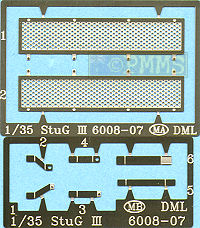 |
Tamiya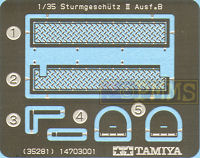  |
Lower Hull:
 Each lower hull is a complete tub with underside details of inspection covers
and the torsion bar attachment points correctly offset and on the sides the
axle locating plates and axle bump stops moulded on with the detail on the
Tamiya hull being slightly more refined than on the Dragon hull.
Each lower hull is a complete tub with underside details of inspection covers
and the torsion bar attachment points correctly offset and on the sides the
axle locating plates and axle bump stops moulded on with the detail on the
Tamiya hull being slightly more refined than on the Dragon hull.
There are a few engineering differences with the upper rear hull overhang and
front final drive extensions included in the Dragon moulding but are separate
parts on the Tamiya hull which allows for some additional detail to be included
on the Tamiya parts.
The rear hull plate is separate on both kits with separate exhaust mufflers and
tow shackles and there are some minor size differences with the tow shackles
and fairly sizable pin marks on the Dragon items. Tamiya do give you the shackle
pins while the Dragon doesn’t and the central round inspection plate is
separate on the Tamiya panel but other than that there is not a lot of difference
between the final results.
The main difference is the Tamiya hull has internal details of floor section, rear bulkhead and lower gun mounting which can be seen if the top hatches are left open while there are no internal details in the Dragon kit.
Running Gear:
 The axles are separate on both kits with the Tamiya kit including movable
axles as described in the full kit review and again the Tamiya axles are
slightly more refined in the details. The additional shock absorber and
bump stop for the first and sixth wheels are also separate parts with again
the Tamiya parts have slightly better details.
The axles are separate on both kits with the Tamiya kit including movable
axles as described in the full kit review and again the Tamiya axles are
slightly more refined in the details. The additional shock absorber and
bump stop for the first and sixth wheels are also separate parts with again
the Tamiya parts have slightly better details.
The road wheels, drive sprockets, idlers and return rollers are the same
size in both kits but again the Tamiya items have more refined details and
also require a bit less cleanup than the Dragon items. The Dragon idlers
and return rollers are marred by some sizable pin marks that will need filling,
quite a difficult job on the return rollers.
Both idlers have separate domed hub caps that include the six bolt heads
while the Tamiya drive sprocket inner disc has rib detail on the inside face
with the Dragon sprocket being plain in this area.
Both kits have separate final drive housings with the Tamiya drive sprockets
held in place with the usual poly caps while the Dragon sprockets are glued
in place.
All this is not to say the Dragon parts are bad, certainly not but just that the Tamiya detail is more refined.
Tracks:
Both kits include 40cm tracks with the Dragon kit having individual plastic
links and the Tamiya kit full length vinyl track. The detail on the vinyl
track is quite good for the medium the detail on the Dragon links is better
defined and includes the small indentations on the side of the guide teeth.
There are some minor pin marks on the inside of each Dragon link that will
need eliminating and the sprue attachment point needs cleanup as with any
individual link track. The links are not workably but simply designed to
be glued together which is easy to do and the resulting track runs are more
detailed than the Tamiya vinyl tracks.
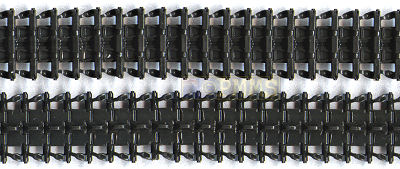
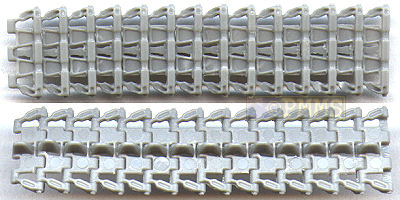
 There is a marked difference in the way each kit handles the upper hull with
the Dragon hull having separate fenders, small rear engine deck inspection
hatches and glacis while the Tamiya hull has the fenders included with hull
moulding and separate large engine deck hatches and glacis inspection hatches.
There is a marked difference in the way each kit handles the upper hull with
the Dragon hull having separate fenders, small rear engine deck inspection
hatches and glacis while the Tamiya hull has the fenders included with hull
moulding and separate large engine deck hatches and glacis inspection hatches.
As mentioned earlier both hulls have minor dimensional discrepancies but that not withstanding both have nicely rendered weld seams around the hull although due to the way the Tamiya upper and lower joins there is no weld seam at the front hull join which is included on the Dragon hull.
The rear engine deck hatches are the same size on both but the Tamiya hinges on the larger hatches are slightly undersized compared to the plans and Dragon deck. The Dragon hatches also have latch detail not present on the Tamiya doors while at the front the Dragon kit has the glacis as a separate part with inspection hatches included while the Tamiya kit has the glacis as part of the hull moulding with separate inspection hatches. The hinges on the Tamiya hatches are slightly oversized as mentioned above but should be easy to fix with the hatches with hinges being separate.
The Dragon engine deck has the attachment fittings for the distinctive figure 8 steel cables when stored while the Tamiya deck is smooth in this area with all the attachment clips included with the separate cable part, this cable is not included in the Dragon kit.
Both kits have separate side engine deck intakes with etched mesh screens with the Dragon kit also having solid plastic embossed screens if you prefer this medium.
At the front both have three part two shackles including the pins but there is a slight size difference between the two with the Tamiya shackles better matching the plans. The Dragon shackles also have sizable pin marks to be removed with smaller ones on the Tamiya parts also while the front headlights have separate front sections on both kits. Those on the Dragon kit are fixed close while the Tamiya front flap can be shown open with etched flaps as an alternative for a finer appearance.
The pioneer tools with moulded on tool clips are separate on both kits as is the fire extinguisher and jack with the Tamiya tools having finer definition than those in the Dragon kit. The Tamiya jack is made up of four parts with separate clips for good definition while the Dragon jack is moulded in one piece including the clips with just the crank handle separate and has a sink mark on one side to deal with. The rear antenna holder has etched supports on both kits but the holder in the Dragon kit is a single part while that in the Tamiya kit is made up of two halves again for good definition.
The rear mudguards are separate on the Tamiya fenders while included with the fenders on the Dragon kit and the Tamiya armoured smoke candle box has better detail than on the Dragon part which is quite plain.
As mentioned the fenders are separate on the Dragon kit and this allows better
defined dot surface pattern as well as other details including the hull/fender
flanges which have bolt head details on both the upper and lower sides while
this section of the Tamiya kit has no detail at all due to being part of the
main hull moulding.
Both have separate fender attachments but these are just for show on the Tamiya kit while used to attach the Dragon fenders to the hull as per the real thing
and will obviously take more effort to attach but the end result will have
better definition.
Superstructure:
 The layout of the superstructure is similar in both kits with separate rear
hatches and front sight hatch but the Dragon kit has the sloping side sections
and storage box as separate parts but the end result is the same. There are
some detail differences with the panel bolts on the Dragon kit being raised
while the Tamiya kit has them as flush screws which is correct and the bullet
splash ribs in the main sight opening are just a series of raised steps on
the Dragon kit but actual raised ribs on the Tamiya kit, these differences
due to the advances in moulding technology over the years.
The layout of the superstructure is similar in both kits with separate rear
hatches and front sight hatch but the Dragon kit has the sloping side sections
and storage box as separate parts but the end result is the same. There are
some detail differences with the panel bolts on the Dragon kit being raised
while the Tamiya kit has them as flush screws which is correct and the bullet
splash ribs in the main sight opening are just a series of raised steps on
the Dragon kit but actual raised ribs on the Tamiya kit, these differences
due to the advances in moulding technology over the years.
The hatches are more detailed on the Dragon kit with latch detail while
both have interior details but with some minor pin marks to contend with
the only difference being the forward sight hatch is moulded closed on the
Dragon kit while separate on the Tamiya kit. This hatch is actually moulded
as one piece on the Tamiya kit with you required to cut them apart to show
the rear sight hatch open as the front portion is closed on most occasions
as shown on the Dragon kit.
Both kits provide the monocular sight that protrudes from the front hatch
with the Tamiya part being the full sight that fits to the interior gun mounting
(see below) while the Tamiya kit also gives you a separate binocular sight
for the rear Commander’s hatch.
The front driver’s plate is similar on both kits with the front visor having a separate armoured flap that can be positioned open or closed as you wish.
A separate rear plate is provided on both kits and both provide separate lifting hooks, grab handles and left side visor cover.
The 7.5cm Gun:
 The external parts for the 7.5cm L/24 Gun are far more detailed on the Tamiya gun with separate upper and lower sections for the recoil housing that includes
nice weld beads and bolt head details with the front section and gun collar
as another separate part. The Dragon kit has the recoil housing and gun collar
moulded together in upper and lower halves with weld beads that are just
solid raised lines and no bolt head detail. The muzzle section is provided
as a hollowed out plastic part in both kits with Tamiya also including a
turned aluminium barrel with rifling inside the muzzle and this is interesting
as the rifling is at an angle where most metal barrels have the rifling parallel
to the barrel length. The rear gun shield has weld beads around the recoil
housing on the Tamiya kit but is plain on the Dragon kit.
The external parts for the 7.5cm L/24 Gun are far more detailed on the Tamiya gun with separate upper and lower sections for the recoil housing that includes
nice weld beads and bolt head details with the front section and gun collar
as another separate part. The Dragon kit has the recoil housing and gun collar
moulded together in upper and lower halves with weld beads that are just
solid raised lines and no bolt head detail. The muzzle section is provided
as a hollowed out plastic part in both kits with Tamiya also including a
turned aluminium barrel with rifling inside the muzzle and this is interesting
as the rifling is at an angle where most metal barrels have the rifling parallel
to the barrel length. The rear gun shield has weld beads around the recoil
housing on the Tamiya kit but is plain on the Dragon kit.
Only the exterior parts are provided in the Dragon kit while the Tamiya kit provides interior parts for the gun breech with separate breech block and side gun guards with lower spent shell catcher, detailed gun mountings and main sight plus crew seat and additional sidewall details.
There is a small error in step 15 of the Tamiya instructions which shows the additional binocular sights fitted through the forward left side hatch when they should be positioned in the rear hatch opening. This would become apparent as the sight mounting (D12) only allows the sight to protrude out the correct hatch but the error may confuse with all subsequent drawings in Step 16 onwards show the sight in the correct hatch. Tamiya have added a correct instruction sheet to their website should you want to download the updated instructions but it is only a minor slip up that shouldn’t be a real problem.
The Tamiya kit also provides a Commander figure which has basic uniform details and while a little plain by today’s standards should paint up okay to stand in the rear hatch if required.
Decals:
The small Dragon decal sheet has rather thick carrier film which has yellowed
on my kit due to the passing years but has markings for two StuGs, one from
StuG Abt226 “Operation Barbarossa” 1941 and 1 Batterie, StuG
Abt191, Balkans 1941.
A larger Tamiya decal sheet of typical quality, i.e. well printed markings with thickish carrier film and includes markings for eight StuG IIIBs with a double sided full colour painting and decal placement guide included which has five view illustrations of three of the options.
The markings include vehicle numbers, unit insignia and divisional markings with different style balkenkreuz with all vehicles finished in overall Panzer Grey.
Tamiya markings are:
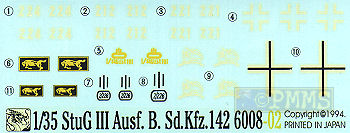
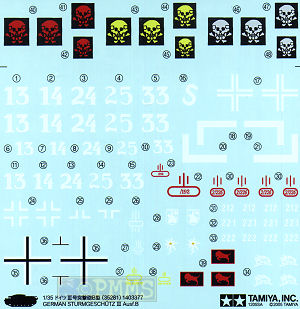
Conclusion:
While some may think comparing a twelve year old kit with a new one is a waste
of time it does show that the Dragon kit has more accurate dimensions even
if only by a few millimetres here and there. Most detail is more refined on
the Tamiya kit which is to be expected but the Dragon fender arrangement is
better than the all in one design of the Tamiya kit and the workable suspension
is a little gimmicky and quite flimsy and both kits allow you to articulate
the suspension if required.
The separate track links of the Dragon kit are also better detailed than the vinyl track of the Tamiya kit and also allows better sagging if you articulate the suspension.
Overall the Tamiya kit is better detailed apart from the minor dimensional issues but if it weren’t you would have to ask why and also includes the interior details that can be seen through the open hatches with most of the detail on the Dragon kit being easily brought up to standard without too much work.
The Tamiya kit offers a wider range of markings and the metal barrel is nice addition and while it takes the points the Dragon kit looks better than the twelve year gap might indicate.
For you consideration.
See an individual review of the Dragon kit HERE
See an individual review of the Tamiya kit HERE
| Sturmgeschutz III Osprey New Vanguard 19 ISBN 1 85532 537 3 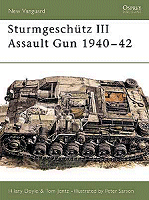 |
"Stug III" Monograph Acción Press/EuroModelismo ISBN 84-95464-40-3 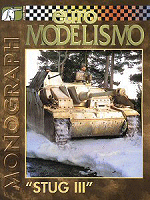 |
Ground Power Magazine #140 1/2006 GALILEO Publishing Co.,Ltd 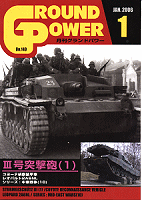 |
| Sturmgeschütz III in action Armor No.2014 Squadron Signal Publications ISBN 0-89747-047-8 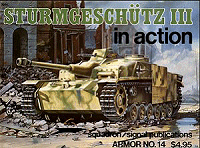 |
Achtung Panzer Vol.5 - Stug III, Stug IV Model Graphix ISBN: 4499226546 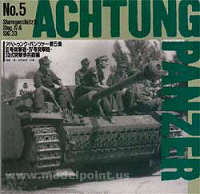 |
Ground Power Magazine #49 6/1998. GALILEO Publishing Co.,Ltd 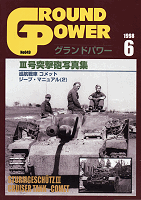 |
Page created January 2, 2006